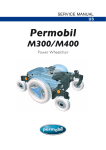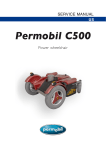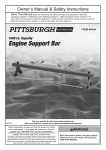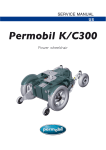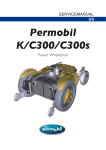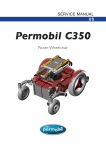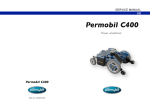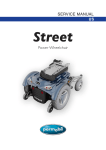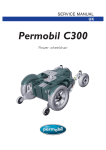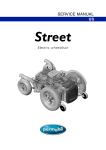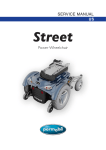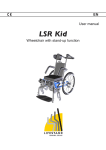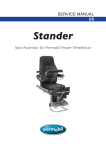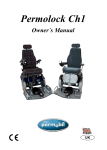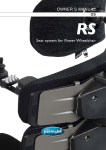Download M300 service manual
Transcript
SERVICE MANUAL US Permobil M300/M400 Power Wheelchair How to contact Permobil Permobil Inc. USA 300 Duke Drive Lebanon, TN 37090 USA Phone: 800-736-0925 Fax: 800-231-3256 Email: [email protected] Head Office of the Permobil group Permobil AB Box 120 861 23 Timrå Sverige Tel: 060-59 59 00 Fax: 060-57 52 50 E-post: [email protected] Produced and published by Permobil AB, Sweden Version 2, 2011-06 Article no.: 205261-US-0 Contents Contents Introduction ...................................................................................................... 5 Serial Number labels ....................................................................................... 6 Covers ............................................................................................................... 8 Batteries .......................................................................................................... 14 Drive wheels ................................................................................................... 18 Casters ............................................................................................................ 20 Shock absorbers ............................................................................................ 22 Link arms ........................................................................................................ 24 Wheel forks ..................................................................................................... 26 Friction brakes ............................................................................................... 27 Drive motors ................................................................................................... 28 Magnetic brake ............................................................................................... 30 Electric seat lift .............................................................................................. 31 Fixed seat tube ............................................................................................... 34 Seat support ................................................................................................... 36 Seats . .............................................................................................................. 38 Control panel .................................................................................................. 42 Power Module ................................................................................................. 44 ICS Master Module ......................................................................................... 48 Lights module . ............................................................................................... 49 Fuses ............................................................................................................... 50 Lights .............................................................................................................. 52 Control system ............................................................................................... 55 Troubleshooting guide R-net......................................................................... 56 Troubleshooting guide VR2........................................................................... 72 Cabling overview R-net ................................................................................. 74 Cabling overview VR2 ................................................................................... 76 Index ................................................................................................................ 78 4 Introduction Introduction The Service Manual is intended for technical personnel who maintain and repair power wheelchairs. It is important that anyone who performs maintenance and repairs described in this manual reads and understands the content of this manual so that the work is performed professionally. Always state the chassis number when contacting Permobil to ensure that the correct information is provided. Technical Support In the event of technical problems, you should contact your dealer, or Permobil Inc. USA at 800-736-0925. Spare parts Spare parts must be ordered through your dealer. Warranties Contact your dealer or Permobil Inc. USA for information about the warranties for this chair. Maintenance See the information in the Owner’s Manual. 5 Serial Number labels Serial Number labels Chassis Chassis ID number. R-net Power Module R-net Power Module ID number. R-net control panel R-net Control panel ID number. 6 Serial Number labels Serial Number labels VR2 Power Module VR2 Power Module ID number. VR2 control panel VR2 control panel ID number. VR2 lights module VR2 Lights module ID number. 7 Covers Covers Removing the front chassis cover 1. Move/fold the leg rests out. 2. Switch off the main power switch on the control panel. 3. Remove the two knobs that hold the cover in place (see fig.). 4. Lift the lower edge of the cover upwards/ forwards. Note that the cover is mounted partially inside the chassis at the lower edge. Assembly The front cover is fitted with two knobs. Assemble in the reverse order. 1. Fit the cover partially inside the chassis at the lower edge (see fig.). 2. Fit the two knobs that hold the cover in place (see fig.). Removing the rear chassis cover 1. Switch off the main power switch on the control panel. 2. If the upper chassis cover isn’t removed, remove it’s rear knobs and lift it’s rear end to release the rear chassis cover, raise the seat if needed. Remove the rear chassis cover by lifting it upwards/backwards. The rear cover is fitted with the upper chassis cover. 3. On wheelchairs equipped with lights, disconnect the rear lights cabling (see fig.). 1 2 1. Left rear Indicator 2. Right rear Indicator 3. Left rear Light 4. Right rear Light Assembly Assemble in the reverse order. 3 1. On wheelchairs equipped with lights, reconnect the rear lights cabling (see fig.). 4 2. Fit the cover partially inside the chassis at the lower edge (see fig. above). 3. Make sure the upper cover holds the rear cover and refit the two knobs (see fig. above). Rear lights cabling connections. 8 Covers Covers Removing the upper chassis cover The cover is fitted with four knobs (see fig.). 1. Move/fold the leg rests out and, if necessary, raise the seat. 2. Switch off the main power switch on the control panel. 3. If fitted, remove the front cover. See page 8. 4. Remove the two remaining knobs holding the cover. (see fig.). 5. Remove the backwards. cover by pulling/lifting it Fitting the upper chassis cover 1. Move/fold the leg rests out and, if necessary, raise the seat. 2. Switch off the main power switch on the control panel. 3. Fit the rear chassis cover before the two rear knobs on the upper chassis cover is fitted (see fig.). The upprer cover is fitted with four knobs. 4. Fit the front chassis cover before the two front knobs on the upper chassis cover is fitted (see fig.). Chassis covers. 9 Covers Covers For this task the following tools are necessary: 1 Torx key TX20. Removing the front link arm covers. Both sides of the link arms have covers fitted. The covers are fitted with four screws. 1. Switch off the main power switch on the control panel. 2. Remove the drive wheel on the side in question (see page 18). 3. Remove the four screws holding the covers (see fig.). Assembly Assemble in the reverse order. 1. Fit the covers using the four screws (see fig.). Front link arm covers. 2. Fit the drive wheel on the side in question (see page 18). Front link arm covers. 10 Covers Covers For this task the following tools are necessary: 1 Torx key TX20. Removing the rear link arm covers. Both sides of the link arms have covers fitted. The covers are fitted with four screws. 1. Switch off the main power switch on the control panel. 2. Remove the chassis rear cover. See page 8. 3. Remove the four screws holding the covers (see fig.). Assembly Assemble in the reverse order. 1. Fit the covers using the four screws (see fig.). 2. Fit the chassis rear cover. See page 8. Rear link arm covers. Rear link arm covers. 11 Covers Covers For this task the following tools are necessary: 1 1 Removing the drive motor covers The drive motor covers are fitted with two screws each. The associated brake release covers are fitted with one screw each. Allen key 3 mm. Allen key 2,5 mm. 1. On wheelchairs equipped with lights and indicators, remove the front and upper chassis cover. (See page 8-9). 2. Remove the drive motor cover, it is attached with two screws (see fig.). The drive motor cover is fitted with two screws. 3. Remove the brake release cover, it is attached with one screw (see fig.). The brake release cover is fitted with one screw. 4. On wheelchairs equipped with lights and indicators, separate the indicators’ cabling at the contact on the cabling. This is positioned on the inside of the chassis, next to the seat lift. The connector on the front indicator cabling. 12 Covers Covers For this task the following tools are necessary: 1 1 Fitting the drive motor covers 1. On wheelchairs equipped with lights and indicators, connect the indicators cabling at the contact on the cabling. This is positioned on the inside of the chassis, next to the seat lift. Allen key 3 mm. Allen key 2,5 mm. The connector on the front indicator cabling. 2. Install the brake release cover using the screw (see fig.). The brake release cover is fitted with one screw. 3. Replace the Drive motor cover with the two screws as per diagram. 4. On wheelchairs equipped with lights and indicators, refit the front and upper chassis cover. (See page 8-9). The drive motor cover is fitted with two screws. 13 Batteries Batteries For this task the following tools are necessary: 1 Wrench 10 mm. m WARNING! Observe care in the use of metallic objects when working with batteries. A short-circuit can easily cause an explosion. Always use protective gloves and protective eye-glasses. Off The batteries are heavy and must be handled with care. On Used or broken drive batteries should be taken care of in an environmentally correct manner in accordance with locally applicable recycling directions. Replacing the front battery 1. Place the wheelchair on a level surface. 2. Move/fold the leg rests out and, if possible, raise the seat lift. Main fuse/battery isolator (On/Off). 3. Switch off the main power switch on the control panel 4. Switch the main fuse to OFF (see fig.). 5. Remove the two knobs that hold the cover in place (see fig.). 6. Lift the lower edge of the cover upwards/ forwards. Note that the cover is mounted partially inside the chassis at the lower edge. The front cover is fitted with two knobs. Front battery connections. 14 Batteries Batteries 7. On Permobil M300, the batteries are secured with battery locks. Remove these by pushing them downwards/towards the center of the chassis (see fig.). On Permobil M300, the batteries are secured with battery locks. 8. Disconnect the battery connections (see fig.). See also the sticker on the inside of the front chassis cover. 9. Lift/pull the battery out of the chassis using the battery belt. m WARNING! Observe care in the use of metallic objects when working with batteries. A short-circuit can easily cause an explosion. Always use protective gloves and protective eye-glasses. The batteries are heavy and must be handled with care. Used or broken drive batteries should be taken care of in an environmentally correct manner in accordance with locally applicable recycling directions. Front battery connections. 10.Lift a new battery into the chassis using the battery belt. Leave the battery belt on the battery. Position the battery with the battery terminals at the front. 11.Refit the battery connections to the new battery (see fig.). See also the sticker on the inside of the front chassis cover. 12.On Permobil M300, refit the battery locks by pushing them downwards and at the same time into the intended recess in the chassis (see fig. above). 13.Fit the cover partially inside the chassis at the lower edge, then secure it with the two knobs. (see fig.). Fit the cover partially inside the chassis at the lower edge. 15 Batteries Batteries For this task the following tools are necessary: 1 Wrench 10 mm. m WARNING! Observe care in the use of metallic objects when working with batteries. A short-circuit can easily cause an explosion. Always use protective gloves and protective eye-glasses. Off The batteries are heavy and must be handled with care. On Used or broken drive batteries should be taken care of in an environmentally correct manner in accordance with locally applicable recycling directions. Replacing the rear battery 1. Place the wheelchair on a level surface. 2. Raise the seat; electric seat lift to the highest position; fixed seat tube to the service position. See page 34. If the electric seat lift does not work normally because the batteries are discharged or the adjustment device is defective, the seat can be raised/lowered manually. See page 31. Main fuse/battery isolator (On/Off). 3. Switch off the main power switch on the control panel 4. Switch the main fuse to OFF (see fig. above). 5. Remove the chassis covers. See page 8-9. 6. Remove the electronics by pulling the locking handles on the left and right handside of the chassis outwards (see fig. below). Disengage the tabs before pulling assembly back. 7. If the wheelchair is equipped with seat support, remove it. See page 36. Remove the electronics by pulling the lockig handles on the left and right handside of the chassis outwards. 16 Batteries Batteries 8. On Permobil M300, the batteries are secured with battery locks. Remove these by pushing them downwards/towards the center of the chassis (see fig.). 9. Disconnect the battery connections (see fig.). See also the sticker on the inside of the rear chassis cover. 10.Lift/pull the battery out of the chassis using the battery belt. m WARNING! Observe care in the use of metallic objects when working with batteries. A short-circuit can easily cause an explosion. Always use protective gloves and protective eye-glasses. The batteries are heavy and must be handled with care. Used or broken drive batteries should be taken care of in an environmentally correct manner in accordance with locally applicable recycling directions. Battery connections and battery locks of the rear battery. 10.Lift a new battery into the chassis using the battery belt. Leave the battery belt on the battery. Position the battery with the battery terminals at the rear. 11.Refit the battery connections to the new battery. See also the sticker on the inside of the rear chassis cover. 12.On Permobil M300, refit the battery locks by pushing them downwards and at the same time into the intended recess in the chassis (see fig. above). 13.If the wheelchair is equipped with seat support, refit it. See page 36. 14.Refit the chassis covers. See page 8-9. 17 Drive wheels Drive wheels For this task the following tools are necessary: 1 Removal Allen key 6 mm. 1. Switch off the main power switch on the control panel. 2. Lift up and chock up the wheelchair chassis so that the wheel in question is free of the ground. 3. Remove the hub cap by pulling it straight out. If necessary, carefully lever it out using a screwdriver in the slot on the cap. 4. Remove the four screws that hold the wheel in place. m WARNING! The central screw must not be removed. 5. Remove the wheel by pulling it straight out. Assembly Assemble in the reverse order. 1. Fit the wheel with the four screws (2). Tighten the four screws using a torque wrench. Tightening torque 17.7 ft-Ibs (24Nm) 2. Align the hubcap on the rim and fit it by pushing it straight in. Pos. 1 2 1 Hub cap 3 Drive wheel 2 3 Description Screw, ISO 4762 M8x20 8.8 Fe/Zn 5 C1 Fitting/removing the Drive wheels. 18 Drive wheels Drive wheels For this task the following tools are necessary: 1 Taking the rim apart Allen key 6 mm. The rim can be taken apart to make it possible to fit/remove solid or pneumatic tires. 1. Remove the wheel in question from the wheelchair. See the previous page. 2. If the tire is pneumatic, release the air. m WARNING! Ensure that pneumatic tires are not pressurized before the rim is taken apart, otherwise there is a risk of personal injury. 3. Remove the six screws holding the two halves of the rim together (see illustration). 4. Take the rim apart. Assembly Assemble in the reverse order. 1. Fit the two rim halves (1&4) together with tire (3) and if pneumatic tire is used, it’s inner tube (2). Tighten the six screws using a torque wrench. Tightening torque: 16.2 ft-Ibs (22Nm) 2. On wheels with pneumatic tires, fill the tire to recommended tire pressure, 29 psi (200 kPa). 3. Fit the wheel on to the wheelchair. See previous page. m WARNING! The recommended tire pressure for pneumatic tires is 29 psi (200 kPa). Overfilling entails a risk of explosion. Incorrect tire pressure may result in lower stability and maneuverability. Check regularly that the tires have the correct pressure. 1 2 3 4 Pos. Description 1 Rim, outer section 3 Tire 2 4 5 Fitting a tire to a split rim. 19 5 Inner tube Rim, outer section Screw, ISO 4762 M8x30 8.8 Fe/Zn Casters Casters For this task the following tools are necessary: 1 Removal Allen key 6 mm. 1. Switch off the main power switch on the control panel. 2. Lift up and chock up the wheelchair chassis so that the wheel in question is free of the ground. 3. Remove the hub cap (4) (see fig. below). 4. Remove the screw (3) and washer (2) (see fig. below). 5. Remove the wheel (1) by pulling it of the axle (see fig. below). Assembly Assemble in the reverse order. 1. Check that the axle and rim are not damaged. If necessary, clean to remove dirt and rust. Replace damaged parts. 2. Fit the wheel on the axle using just your hands. Check that the wheel is fully located on the axle. 3. Fit the washer (2) on to the screw (3). 4. Fit the screw (3) and washer (2) on to the axle. Tighten the screw with a torque wrench. Tightening torque: 24 ft-Ibs (33Nm) 5. Fit the hubcap (4). m CAUTION! The screw must only be used once. Once removed, the screw must therefore never be refitted. Do not use an impact wrench for the tightening torque. Pos. m WARNING! 1 Wheel 3 Screw, ISO 4762 M8x16 10.9 Fe/Zn 2 No type of screw and washer other than those stated here may be used. 4 1 Description Washer, 8,5x23x3 Hub cap 2 Attaching/removing the casters. 20 3 4 Casters Casters For this task the following tools are necessary: 1 Taking the rim apart Allen key 5 mm. The rim can be taken apart to make it possible to fit/remove solid tires. 1. Remove the wheel in question from the wheelchair. See the previous page. 2. Remove the three screws holding the two halves of the rim together (see illustration). 3. Take the rim apart. Assembly Assemble in the reverse order. 1. Fit the two rim halves (2&4) together with tire (3). 2. Tighten the three screws using a torque wrench. Tightening torque: 7.2 ft-Ibs (9.8Nm) 3. Fit the wheel on to the wheelchair. See previous page. 1 4 3 2 Pos. Description 1 Locking nut, ISO 7040 M6 8 FE/n 3 Tire, Solid 200x50 2 4 5 Fitting a tire on the split rim. 21 5 Rim, inner section Rim, outer section Screw, ISO 4762 M6x30 8.8 Fe/Zn Shock absorbers Shock absorbers For this task the following tools are necessary: 1 Removal Allen key 6 mm. 1. Raise the seat; electric seat lift to the highest position; fixed seat tube to the service position. See page 34. If the electric seat lift does not work normally because the batteries are discharged or the adjustment device is defective, the seat can be raised/lowered manually. See page 31. 2. Switch off the main power switch on the control panel. 3. Remove the chassis covers. See page 8-9. 4. Lift up and chock up the wheelchair chassis so that the wheel in question is free of the ground. 6. Remove the shock absorber, it’s fitted with two screws (see fig. below). Assembly Assemble in the reverse order. 1. Lubricate the bearing points (1) of the shock absorber with grease before fitting. 2. Fit the shock absorber using the two screws and washers (see fig. below). 3. Adjust the shock absorber spring force. See page 23. 1 Fitting/removing the Shock absorber. 22 Shock absorbers Shock absorbers Adjusting shock absorber spring force The spring force of the shock absorber must be adjusted to the correct value. The spring force can be adjusted to suit different body weights by means of the adjusting nut. To get the best comfort and performance the shock absorber should be adjusted as marked on the shock absorber (see fig. below). Setting Adjusting nut A >90Kg / >199Ibs B 91-136Kg / 200-300Ibs Shock absorber adjusted to setting ”A”. 23 User weight Link arms Link arms For this task the following tools are necessary: 1 Removal of rear link arms Allen key 6 mm. 1. Switch off the main power switch on the control panel. 2. Lift up and chock up the wheelchair chassis so that the wheel in question is free of the ground. 3. Remove the drive wheel. See page 18. 4. Remove the lower shock absorber bracket (see fig.). 5. Remove the cover (6) from the link arm by pulling it straight out (see fig.). below. 6. Remove the link arm (3), it’s fitted with the screw (5) and the washer (4) (see fig. below). For removal of wheel forks and wheels, see the respective chapters. Shock absorber lower bracket. Assembly of rear link arms Assemble in the reverse order. 1. Check that the axle and link arm are not damaged. If necessary, clean to remove dirt and rust. Replaced damaged parts. 2. Fit the link arm on the axle using just your hands. Check that the guide (2) of the rear link arm is correct positioned in the groove (1) of the front link arm and that the link arm is fully located on the axle (see fig. below). 3. Fit the screw (5) and washer (4). Tighten the screw with a torque wrench. Tightening torque: 17.7 ft-Ibs (24Nm) Item 4. Fit the cover (6) on the link arm (see fig. below). 1 Rear Link Arm. 3 Screw ISO 4762 M8x20 8.8 Fe/Zn 2 5. Fit the lower shock absorber bracket (see fig. above). 4 6. Fit the drive wheel. See page 18. Description Washer, 32x8,1x3 Cover 2 1 3 4 5 6 Fitting/removing the Rear Link Arm. 24 Link arms Link arms For this task the following tools are necessary: 1 Removal of front link arms Allen key 6 mm. 1. Raise the seat; electric seat lift to the highest position; fixed seat tube to the service position. See page 34. If the electric seat lift does not work normally because the batteries are discharged or the adjustment device is defective, the seat can be raised/lowered manually. See page 31. 2. Switch off the main power switch on the control panel. 3. If the wheelchair is equipped with lights, disconnect the front light in question. See page 52. 4. Lift up and chock up the wheelchair chassis so that the wheel in question is free of the ground. 5. Remove the drive wheel. See page 18. 6. Remove the rear link arn. See previous page. 7. Remove the cover (4) from the link arm by pulling it straight out (see fig. below). 8. Remove the link arm (1), it’s fitted with the screw (3) and the washer (2) (see fig. below). For removal of wheel forks and wheels, see the respective chapters. Assembly of front link arms Assemble in the reverse order. 1. Check that the axle and link arm are not damaged. If necessary, clean to remove dirt and rust. Replaced damaged parts. 2. Fit the link arm on the axle using just your hands. Check that the link arm is fully located on the axle (see fig. below). Item 3. Fit the screw (3) and washer (2). Tighten the screw with a torque wrench. Tightening torque: 17.7 ft-Ibs (24Nm) 1 Front link arm. 3 Screw ISO 4762 M8x20 8.8 Fe/Zn 2 Washer, 32x8,1x3 4 4. Fit the cover (4) on the link arm. (see fig. below). Description Cover 5. Fit the rear link arm. See previous page. 6. Fit the drive wheel. See page 18. 7. If the wheelchair is equipped with lights, connect the front light in question. See page 52. 4 3 2 1 4 Fitting/removing the Front Link Arm. 25 Wheel forks Wheel forks For this task the following tools are necessary: 1 Removal Allen key 6 mm. 1. Switch off the main power switch on the control panel. 1 3. Remove the wheel. See page 20. 2 5. Remove the wheelfork, it’s fitted with the screw (2) and washer (3) from above (see fig.). Also remove the friction brake (4) by pulling it straigt out of the bearing house of the link arm. 3 2. Lift up and chock up the wheelchair chassis so that the wheel in question is free of the ground. 4. Remove the cover (1) on top of the link arm. 4 Assembly Assemble in the reverse order. 1. Check that the wheel fork and link arm with bearings and friction brake are not damaged. If necessary, clean to remove dirt and rust. Replaced damaged parts. 2. Fit the wheel fork on the linkarm using just your hands. Check that the wheel fork is fully located on the linkarm. 6 7 3. If needed, clean the friction brake and then lubricate it with Friction brake grease, order no: 1820405 before fitting it in the bearing house of the link arm, see page. 27. 4. Fit the screw (2) and washer (3) from above (see fig.). Tighten the screw with a torque wrench. Tightening torque: 17.7 ft-Ibs (24Nm) 8 m CAUTION! Do not use an impact wrench for the tightening torque. Wheel fork. 5. Fit the cover (1) on the link arm (see fig.). 6. Fit the wheel. See page 20. Item 1 Cover 3 Washer, ISO 7089 8 200 HV Fe/Zn (8,4x16x1,6) 2 4 5 Screw, ISO 4762 M8x20 8.8 FE/Zn Friction brake Bearing, 6002-2RS1 (15x32x9) 6 Link arm 8 Wheel fork 7 26 Description Spacer, Ø16xØ22x12,5 5 Friktionsbroms Friction brakes For this task the following tools are necessary: The casters are equipped with friction brakes working as anti flutter devices. 1 Allen key 6 mm. 1 Removal 1. Switch off the main power switch on the control panel. 2 2. Remove the cover (1) on the link arm (see fig.). 3 3. Remove the friction brake (4), it is fitted with the screw (2) and washer (3) from above (see fig.). 4 4. Remove the two o-rings from the friction brake. Assembly Assemble in the reverse order. 1. If needed, clean the friction brake parts. Lubricate the parts with Friction brake grease, order no: 1820405 before fitting them together. 2. If needed, clean the link arm bearing house before the friction brake is fitted. 3. Fit the friction brake (4) with the screw (2) and washer (3) (see fig.). Tighten the screw with a torque wrench. Tightening torque: 17.7 ft-Ibs (24Nm) 4. Fit the cover(1) on top of the link arm (see fig.). Friction brake. m CAUTION! Do not use an Impact Wrench to tighten 27 Drive motor Drive motor For this task the following tools are necessary: 1 1 Removal 1. Raise the seat; electric seat lift to the highest position; fixed seat tube to the service position. See page 34. If the electric seat lift does not work normally because the batteries are discharged or the adjustment device is defective, the seat can be raised/lowered manually. See page 31. Allen key 5 mm. Allen key 6 mm. 2. Switch off the main power switch on the control panel. 3. Remove the chassis covers. See page 8-9. 4. Lift up and chock up the wheelchair chassis so that the wheel in question is free of the ground. 5. Remove the drive wheel. See page 18. 6. Separate the magnetic brake and drive motor cabling at the contacts on the cabling. These are positioned on the inside of the chassis, next to the seat lift. (see fig.). The contacts are mounted together in a holder. The contacts are mounted together in a holder. 7. Run the connection cables out through the chassis cable duct. 8. Remove the drive motor, it’s fitted with four screws (see fig.). Item 1 2 1 Description Screw ISO 4762 M6x60 8.8 Fe/Zn Washer, ISO 7089 6 200 HV Fe/Zn 5 C1(6,4x12x1,6) 2 Fitting/removing the Drive motor. 28 Drive motor Drive motor For this task the following tools are necessary: 1 1 Assembly Assemble in the reverse order. Allen key 5 mm. Allen key 6 mm. 1. Fit the drive motor with the four screws and washers (see fig. below). 2. Run the connection cables in through the chassis cable duct. 3. Connect the magnetic brake and drive motor cabling at the contacts on the cabling. These are positioned on the inside of the chassis, next to the seat lift/seat tube (see fig.). Fit the contacts together in their holder. 4. Fit the drive wheel. See page 18. 5. Fit the chassis covers. See page 8-9. m CAUTION! The contacts are mounted together in a holder. Check the function of the brake release after fitting. When the brakes are released, it should not be possible to drive the wheelchair. Item 1 2 1 Description Screw ISO 4762 M6x60 8.8 Fe/Zn Washer, ISO 7089 6 200 HV Fe/Zn 5 C1(6,4x12x1,6) 2 Fitting/removing the Drive motor. 29 Magnetic brakes Magnetic brakes For this task the following tools are necessary: 1 1 The wheelchair is equipped with a magnetic brake on the left and right drive motor. The magnetic brakes are both equipped with a brake release lever which is used to manually release the brakes. Allen key 3 mm. Allen key 2,5 mm. Removal of magnetic brake. 1. Switch off the main power switch on the control panel. 2. Remove the upper chassis cover. See page 9. 3. Remove the drive motor cover. See page 12. 4. Separate the magnetic brake cabling at the contacts on the cabling. This is positioned on the inside of the chassis, next to the seat lift. The contact is mounted together with the drive motor contact in a holder. 5. Run the connection cable out through the chassis cable duct. The contacts are mounted together in a holder. 6. Remove the magnetic brake, it’s fitted with three screws (see fig.). Assembly Assemble in the reverse order. 1. Fit the magnetic brake with the brake release lever pointing upwards using the three screws (see fig.). 2. The brake release lever has an end position screw which is mounted in different positions depending on if the magnetic brake is mounted on the chassis right or left drive motor. On delivery of a new brake release, the end position screw is mounted on the end of the brake release lever. Fit the end position screw to the side of the brake release lever that points agains the center of the chassis (see fig. below). 3 Connect the magnetic brake cable at the connector. This is positioned on the inside of the chassis, next to the seat lift. Fit the contact together with the drive motor contact in a holder. 4. Fit the drive motor cover. See page 13. 5. Fit the chassis cover. See page 9. The magnetic brake is fitted with three screws. m CAUTION! Check the function of the brake release after fitting. When the brakes are released, it should not be possible to drive the wheelchair. The brake release lever has an end position screw which is mounted in different positions depending on if the magnetic brake is mounted on the chassis right or left drive motor. 30 Electric seat lift Electric seat lift For this task the following tools are necessary: 1 1 Manual operation of electric seat lift If the seat lift does not work normally because the batteries are discharged or the adjustment device is defective, the seat can be raised/lowered manually. Allen key 4 mm. Seat Lift Crank 1. Switch off the main power switch on the control panel. 2. Remove the cushion from the seat by lifting it straight up. 3. Remove the seat plate. The seat plates on Corpus 3G are held in place by two screws at the back edge and two quick-mount clamps at the front. The seat plates on PS seat are held in place by four screws. 4. Raise/lower the seat using the seat lift crank supplied. m WARNING! Drills must not be used in connection with manual operation of the seat lift. There is a risk of damage to materials. Manual raising/lowering of the Corpus seat using the seat lift crank. 31 Electric seat lift Electric seat lift For this task the following tools are necessary: 1 Removal Allen key 5 mm. 1. Raise the seat to the highest position. If the electric seat lift does not work normally because the batteries are discharged or the adjustment device is defective, the seat can be raised/lowered manually. See page 31. 2. Switch off the main power switch on the control panel. 3. Remove the upper chassis cover. See page 9. 4. Remove the seat including the seat tilt mechanism if the wheelchair is equipped with such device. See page 36-40. m WARNING! The seat is heavy. This work should therefore always be performed by two people. Be careful with the cabling. ICS General Module is fitted at the rear of the chassis. 5. If the wheelchair is equipped with seat support, remove it. See page 36. 6. Remove the seat lift, it’s fitted with four screws (see fig. below). 7. VR2 Separate the seat lift cabling at the contacts on the cabling. R-net Disconnect the seat lift cabling from the ICS general module. 8. Lift the seat lift straight up out of the chassis. ICS General Module. 32 Electric seat lift Electric seat lift For this task the following tools are necessary: 1 Assembly Allen key 5 mm. Assemble in the’reverse order. 1. Fit the seat lift into the chassis using the four screws (see fig. below). If the wheelchair is equipped with seat support, mount it. See page 36. 2. VR2 Connect the seat lift cabling at the connector on the cabling. R-net Connect the seat lift cabling to the ICS general module. ICS General Module is fitted at the rear of the chassis. 3. Fit the seat including the seat tilt mechanism if the wheelchair is equipped with such device. See page 36-40. m WARNING! The seat is heavy. This work should therefore always be performed by two people. Be careful with the cabling. 4. Fit the upper chassis cover. See page 9. ICS General Module. 33 Fixed seat tube Fixed seat tube For this task the following tools are necessary: Service position 1 1 The fixed seat tube can be raised to the service position to make it easier to set the fixed seat height and other service tasks on the wheelchair. Allen key 5 mm. Allen key 6 mm. 1. Loosen the screw that locks the fixed height position of the seat tube (see fig.). The seat is now pressed upwards by the integrated gas spring of the seat tube. 2. Lock the seat tube in the upper position using the screw before starting any other work (see fig.). m WARNING! Always lock the seat tube in the upper position using the screw before starting any other work. To return to normal position, undo the screw locking the seat tube height position, and push the seat downwards until the head of the height adjustment screw is in the recess in the outer tube of the seat tube (see illustration). Locking screw for the seat tube height position. m WARNING! The seat must not be subjected to load and the wheelchair must not be driven with the fixed seat tube in the service position. Make sure that the head of the height adjustment screw is in the recess in the outer tube of the seat tube after work is completed. Adjusting the seat height The length of the fixed seat tube can be adjusted to five different fixed positions. 1. Adjust the seat tube to the service position (see above). 2. Screw the height adjustment screw in place in the desired height position. See the illustration. The three holes in positions that raise the seat above the standard position are plugged with plastic screws. If one of these three holes is to be used, the plastic screw must first be removed. With the seat Corpus 3G the height adjustment screw should never be mounted in position 1 or 2. See fig. Turn the seat so that the height adjustment screw ends up in the groove in the outer tube. 1 Standard position Not for Corpus 3G Recommended position for Corpus 3G 2 3 4 5 Position of the height adjustment screw. 34 Fixed seat tube Fixed seat tube 3. Undo the screw locking the seat tube height position, and push the seat downwards. Turn the seat so that the head of the height adjustment screw is in the groove in the outer tube of the seat tube (see illustration). 4. Tighten the screw that locks the fixed height position of the seat tube. Turn the seat so that the height adjustment screw ends up in the groove in the outer tube. Removing the fixed seat tube 1. Raise the seat to the service position (see previous page). 2. Switch off the main power switch on the control panel. For this task the following tools are necessary: 1 3. Remove the upper chassis cover. See page 9. Allen key 5 mm. 4. Remove the seat including the seat tilt mechanism if the wheelchair is equipped with such device. See page 36-40. m WARNING! The seat is heavy. This work should therefore always be performed by two people. Be careful with the cabling. 5. Remove the seat tube by unscrewing the four screws (see fig.). 6. Lift the seat tube straight up out of the chassis. Assembly Assemble in the reverse order. The Fixed seat tube is fitted with four screws. 35 Seat support Seat support For this task the following tools are necessary: 1 The chassis can be equipped with a seat support. The seat support is fitted behind the seat lift. Allen key 5 mm. 1. Raise the seat to the highest position. If the electric seat lift does not work normally because the batteries are discharged or the adjustment device is defective, the seat can be raised/lowered manually. See page 31. 2. Switch off the main power switch on the control panel. 3. Remove the upper chassis cover. See page 9. 4. Remove the seat support, it is fitted with two screws. Se fig. below. 5. Lift the seat support out of the chassis. If the seat support is not supposed to be refitted, refit the right screw which also holds the seat lift (see fig. below). Assembly Assemble in the reverse order. 1. Fit the rubber cushion according to description on page 37. 2. If fitted, remove the rear right fastening screw of the seat lift. 3. Place the seat support in the chassis and mount it with the two screws (see fig. below). The right screw holds both seat support and seat lift. 4. Refit the upper chassis cover. See page 9. The Seat support is fitted with two screws. 36 Seat support Seat support Removal of rubber cushion 1. Remove the rubber cushion by turning it counterclockwise (see fig.). For this task the following tools are necessary: 1 Allen key 5 mm. Fitting of rubber cushion The rubber cusions bracket can be fitted in two different positions, laying down or standing. This is to suit both standard Tilt and Anterior Tilt (-5°). Fit the bracket laying down together with ”standard tilt”. Fit the bracket standing together with Anterior tilt (-5°) (see fig. below). Changing the position of the bracket 1. Remove the seat support. See description on previous page. 2. Remove the rubber cushion bracket, it is fitted with two screws from underneath (see fig.). 3. Rotate the bracket 90° and fit with the two screws (see fig.). 4. Fit the rubber cushion On wheelchairs without seat tilt mechanism, fit the spacer on the bracket by turning it clockwise untill it is fully located on the bracket. 5. Fit the rubber cushion without washers by turning it clockwise untill it is fully located on the bracket, or on wheelchair without seat tilt mechansim, untill it is fully located on the long spacer. Lower the seat lift. Verify how the height of the seat support correspond with the height of the seat when the seat lift has reched its lowest position. At the correct height the rubber cushion should be compressed 3 mm. as the seat lift reaches its lowest position. 6. If needed, adjust the seat support height Adjust the height of the seat support by raising the seat lift, removing the rubber cushion and fit suitable number of the attached washers between the rubber cushion and its bracket, or on wheelchair without seat tilt mechansim, between the rubber cushion and the long spacer. After performed adjustment, verify how the height of the seat support correspond with the height of the seat when the seat lift has reached its lowest position. At the correct height the rubber cushion should be compressed 3 mm. If needed, perform the adjustment once again. The spacer is only used on chassis without seat angle mechansim. The rubber cushion’s bracket can be fitted in two different positions, laying down or standing. The spacer is only used on chassis without seat angle mechansim. 37 Seats Seats For this task the following tools are necessary: Removal of Corpus 3G 1 1 1. Raise the seat to the highest position. If the electric seat lift does not work normally because the batteries are discharged or the adjustment device is defective, the seat can be raised/lowered manually. See page 31. Allen key 5 mm. Allen key 6 mm. 2. Switch off the main power switch on the control panel. 3. Remove the cushion from the seat. 4. Remove the seat plates, which are held in place by two screws at the back edge and two quickmount clamps at the front. See the illustration. First remove the screws, then use your hand to carefully push the seat plate from below to release the quick-mount clamps at the front. The seat plates on Corpus 3G are held in place by two screws at the back edge and two quickmount clamps at the front. 5. Remove the control panel. Loosen the control panel cabling from its fixing points. Remember how the cabling is positioned; this helps when you come to re-attach it. 6. On wheelchair equipped with seat tilt, separate the cabling for the seat angle mechanism at the contact on the cabling. The contact is at the front right corner of the seat angle mechanism, next to the other cabling (see fig.). The connector is on the cabling at the front right corner of the seat angle mechanism, next to the rest of the cabling 7. Remove the four screws that hold the seat in place (see fig.). The seat can be mounted in three different positions, depending on the currant seat depth. Note the position the seat is mounted in for future reference. 8. Lift the seat off the seat lift/seat column. m WARNING! The seat is heavy. This work should therefore always be performed by two people. Be careful with the cabling. The seat is held in place by four screws. 38 Seats Seats For this task the following tools are necessary: Assembly of Corpus 3G 1 1 Assemble in the reverse order. 1. Mount the seat using the four screws. See the fig. It can be mounted in three different positions, depending. For more information, see the seats service manual. Allen key 5 mm. Allen key 6 mm. 2. Fit the control panel. See page 42-43. Re-attach the cabling to its fixing points. The seat is held in place by four screws. 3. Mount the seat plates by first mounting them with the quick-mount clamps at the front and then the screws at the back. Fit the quickmount clamps by pushing them straight into the holes. 4. Fit the cushion in desired position by pressing it against the seat plates. 5. Lower the seat to desired position. If the electric seat lift does not work normally because the batteries are discharged or the adjustment device is defective, the seat can be raised/ lowered manually. See page 31. The seat plates on Corpus 3G are held in place by two screws at the back edge and two quickmount clamps at the front. 39 Seats Seats For this task the following tools are necessary: Removal of PS on chassis without seat angle mechanism. 1 1 Allen key 5 mm. Allen key 6 mm. 1. Raise the seat to the highest position. If the electric seat lift does not work normally because the batteries are discharged or the adjustment device is defective, the seat can be raised/lowered manually. See page 31. 2. Switch off the main power switch on the control panel. 3. Remove the seat cushion. 4. Remove the seat plates, which are held in place by four screws (see fig.). The seat plates are mounted with four screws. 5. Remove the control panel. See page 42-43. Cut off the cable ties holding the cabling in place on the seat, noting the position of the cable ties for subsequent fitting. 6. Remove the four screws that hold the seat in place. See the fig. 7. Lift the seat off the seat lift/seat column. m WARNING! The seat is heavy. This work should therefore always be performed by two people. Be careful with the cabling. The seat is mounted with four screws. Assembly of PS Assemble in the reverse order. 1. Mount the seat using the four screws. See the fig. 2. Fit the control panel. See page 42-43. Re-attach the cabling to its fixing points. 3. Mount the seat plates with the four screws. 4. Fit the cushion in desired position by pressing it against the seat plates. 40 Seats Seats For this task the following tools are necessary: Removal of PS on chassis with seat angle mechanism. 1 Allen key 5 mm. 1. Raise the seat angle. 2. Switch off the main power switch on the control panel. 3. Remove the control panel. See page 42-43. Cut off the cable ties holding the cabling in place on the seat, noting the position of the cable ties for subsequent fitting. 4. Separate the cabling for the seat angle mechanism at the contact on the cabling. The contact is at the front right corner of the seat angle mechanism, next to the other cabling (see fig.). 4. Remove the four screws holding the seat (see fig. below). The connector is on the cabling at the front right corner of the seat angle mechanism, next to the rest of the cabling 4. Lift the seat off. m WARNING! The seat is heavy. This work should therefore always be performed by two people. Be careful with the cabling. Assembly of PS Assemble in the reverse order. 1. Position the seat and fit with the four screws (see fig.). Tighten the screw with a torque wrench. Tightening torque: 17.7 ft-Ibs (24Nm) 2. Connect the cabling for the seat angle mechanism at the contact on the cabling. The contact is at the front right corner of the seat angle mechanism, next to the other cabling (see fig.). 3. Fit the control panel. See page 42-43. Fit the cabling with cable ties. The seat is fitted with four screws. 41 Control Panel Control Panel R-net For this task the following tools are necessary: Removal 1 Allen key 4 mm. 1. Switch off the main power switch on the control panel. 2. Loosen the control panel cabling from its fixing points. Remember how the cabling is positioned; this helps when you come to re-attach it. On Corpus 3G, a cover (3) on the the arm rest has to be removed, it is fitted with two screws. 3. Separate the control panel cabling at the connector on the cabling. 4. Remove the control panel (1). It is held in place with two screws (see illustration). These two screws also hold the bracket for the ICS control panel (2), if there is one fitted (see illustration). Assembly Assemble in the reverse order. 1. Fit the control panel (1) with the two screws (see fig.). Also fit the bracket for the ICS control panel (2), if the wheelchair is equipped with one, with the same screws (see fig.). 2. Connect the control panel cabling at the connector on the cabling. 3. Re-attach the cabling to its fixing points. On Corpus 3G, refitt the cover (3) on the the arm rest using the two screws. 1 2 3 The control panel is attached with two screws. On Corpus 3G the Control Panel connector is positioned behind a cover (3) on the armrest. 42 Control Panel Control panel VR2 For this task the following tools are necessary: Removal 1 Allen key 4 mm. 1. Remove the upper and rear chassis cover. See page 8. 2. Loosen the control panel cabling from its fixing points. Remember how the cabling is positioned; this helps when you come to re-attach it. 3. Disconnect the control panel cabling from the Power Module (see illustration). 4. Remove the control panel (4). It is held in place with two screws underneath (see illustration). The control panel cabling is connected to the Power Module. Assembly Assemble in the reverse order. 1. Fit the control panel (4) with the two screws (see fig.). 2. Connect the control panel cabling to the Power Module (see illustration). 3. Re-attach the cabling to its fixing points. 4. Refit the upper and rear chassis cover. See page 8 4 The control panel is held in place with two screws. 43 Power Module Power Module R-net For this task the following tools are necessary: 1 Removal Wrench 8 mm. 1. Switch off the main power switch on the control panel. 2. Switch the main fuse to OFF. See page 50. 3. Remove the chassis covers. See page 8-9. 4. Remove the electronics by gently pulling/ spreading the locking handles to disengage the locking tabs on the left and right hand side of the chassis (see fig.). Remove the electronics by gently pulling the locking handles on the left and right side of the chassis outwards and disengaging the tabs. 5. Disconnect the electrical connections from the Power Module. Note their positions (see fig. below). Inhibit Motor 1 Left Motor 2 Right Battery Power Module cable connections 44 External charging socket Power Module 6. Remove the Power Module, it is fitted with two nuts (see fig. below). The Power Module is fitted with two nuts. Assembly Assemble in the reverse order.¨ 1. Fit the Power Module with the two nuts (see fig. above). 2. Connect the electrical connections to the Power Module. Note their positions (see fig. on previous page). 3. Fit the Power Module bracket with its lower section partly inside the rear edge of the chassis. Secure the electronics with the lock handles on the left and right hand side of the chassis making sure the tabs are reengaged (see fig. on previous page). 4. Fit the chassis covers. See page 8-9. 5. Switch the main fuse to ON. See page 50. 45 Power Module Power Module VR2 For this task the following tools are necessary: 1 Removal Wrench 8 mm. 1. Switch off the main power switch on the control panel. 2. Switch the main fuse to OFF. See page 50. 3. Remove the chassis covers. See page 8-9. 4. Remove the electronics by gently pulling/ spreading the locking handles to disengage the locking tabs on the left and right hand side of the chassis (see fig.). Remove the electronics by gently pulling the locking handles on the left and right side of the chassis outwards and disengaging the tabs. 5. Disconnect the electrical connections from the Power Module. Note their positions (see fig. below). Control Panel Motor 1 Left Motor 2 Right Battery Inhibit External charging socket Actuators Power Module cable connections 46 Power Module 6. Remove the Power Module, it is fitted with two nuts (see fig. below). The Power Module is fitted with two nuts. Assembly Assemble in the reverse order.¨ 1. Fit the Power Module with the two nuts (see fig. above). 2. Connect the electrical connections to the Power Module. Note their positions (see fig. on previous page). 3. Fit the Power Module bracket with its lower section partly inside the rear edge of the chassis. Secure the electronics with the lock handles on the left and right hand side of the chassis making sure the tabs are reengaged (see fig. on previous page). 4. Fit the chassis covers. See page 8-9. 5. Switch the main fuse to ON. See page 50. 47 ICS Master Module ICS master module (Only applies to chassis with R-net.) The wheelchair seat may be equipped with an ICS control system, and if so, the seat is controlled from the system’s ICS master module. This is fitted in the wheelchair chassis. Removal 1. Raise the seat to the highest position. If the electric seat lift does not work normally because the batteries are discharged or the adjustment device is defective, the seat can be raised/lowered manually. See page 31. 2. Switch off the main power switch on the control panel. ICS master module loose in its holder. 3. Remove the chassis covers. See page 8-9. 4. Pull the master module straight out of its holder (see fig.). 5. Pull the cover off. 6. Cut off the cable ties that hold the cables and detach the electrical connections. Note their positions for subsequent fitting. Assembly Assemble in the reverse order. ICS master module with cover removed. 48 Lights module Lights module For this task the following tools are necessary: (Not Available in All Markets, only applies to chassis with VR2 and lights.) 1 Wrench 8 mm. Removal 1. Switch off the main power switch on the control panel. 2. Remove the chassis covers. See page 8-9. 3. The light module is fitted at the rear of the chassis. Disconnect the electrical connections from the lights module. Note their positions for subsequent fitting. 4. Remove the lights module, it is fitted with two nuts (see fig.). Assembly Assemble in the reverse order. The lights module is held in place with two nuts. 1. Fit the lights module with the two nuts (see fig.). 2. Connect the electrical connections to the lights module. 3. Fit the chassis covers. See page 8-9. 49 Fuses Fuses Resetting the main fuse The main fuse also functions as a battery isolator but it is usually called the main fuse. Off On It is not normally necessary to replace the main fuse as it is automatic and can be reset when it has been triggered. The main fuse can be accessed through a recess in the rear chassis cover. It is reset by switching the switch to ON (see fig.). m CAUTION! Main fuse/battery isolator (On/Off). If the main fuse is triggered, there is often a major electrical fault. The cause of the fault should be checked carefully before the fuse is reset. Removal For this task the following tools are necessary: 1. Remove the chassis covers. See page 8-9. 1 1 2. Switch the main fuse to OFF (see fig. above). Wrench 6 mm. Phillips head screwdriver m CAUTION! 3. Detach the negative cable from the rear battery. 4. Detach the positive cable from the front battery. Fold the battery connection cables under so they cannot come into contact with the battery terminals. 5. Remove the main fuse, which is held in place with two nuts (see fig. below). On chassis with VR2 Control System the Main Fuse is fitted with two nuts. On chassis with R-net Control System the Main Fuse is fitted with two nuts. 6. Disconnect the cables from the mail fuse by loosening the screws (see fig.). m CAUTION! Note the direction in which the fuse is installed for subsequent fitting. The ON/OFF position must match the appropriate sticker on the chassis. Main fuse cable connection. 50 Fuses Fuses For this task the following tools are necessary: 1 1 Assembly Assemble in the reverse order. Wrench 6 mm. Phillips head screwdriver 1. Switch the new main fuse to OFF. 2. Connect the cables to the new main fuse. m CAUTION! Note the direction in which the fuse is installed for subsequent fitting. The ON/OFF position must match the appropriate sticker on the chassis. Check that the cables are firmly attached. Main fuse cable connection. 3. Fit the new main fuse on the bracket with the two nuts (see fig. below). 4. Reattach the battery connection cables to the batteries. 5. Fit the chassis covers. See page 8-9. On chassis with VR2 Control System the Main Fuse is fitted with two nuts. On chassis with R-net Control System the Main Fuse is fitted with two nuts. 6. Switch the main fuse to ON (see fig.). Off On Main fuse/battery isolator (On/Off). 51 Lights Lights (accessories) For this task the following tools are necessary: 1 1 Removing the front lights & indicators 1. Switch off the main power switch on the control panel. Torx key TX20. Allen key 3 mm. 2. Remove the front and upper chassis covers. See page 8-9. Removal of lights 3. Disconnect the lights at the connection on the cabling. This is positioned on the inside of the chassis, next to the seat lift (see fig.). The conectors on the front light and indicators cabling. 4. Remove the front link arm covers. See page 10. Take note of how the lights cabling is placed underneath the cover of the linkarm (see fig.). 5. Remove the light, it’s mounted with two screws (see fig.). The front lights are mounted with two screws. Removal of indicators 6. Disconnect the indicator lights at the connector on the cabling. This is positioned on the inside of the chassis, next to the seat lift. 7. The indicators are delivered mounted on the drive motor cover. Remove the drive motor cover, it’s fitted with two screws (see fig.). The Drive Motor Cover is fitted with two screws. 52 Lights Lights (accessories) For this task the following tools are necessary: 1 1 Assembly of front lights & indicators Assemble in the reverse order. Torx key TX20. Allen key 3 mm. Assembly of lights 1. Fit the light with the two screws. Adjust the light to desired angle before tightening the upper screw (see fig.). 2. Fit the front link arm covers. See page 10. Take care of how the lights cabling is placed underneath the cover of the linkarm (see fig.). 3. Connect the indicators cabling at the connectors on the cabling. This is positioned on the inside of the chassis, next to the seat lift. The front light is fitted with two screws. Assembly of indicators 4. The indicators are delivered mounted on the drive motor cover. Fit the drive motor cover, it’s fitted with two screws (see fig.). Fit the indicators cabling together with the drive motor cabling in to the wheelchairs chassis. 5. Connect the indicators cabling to the connectors on the cabling. This is positioned on the inside of the chassis, next to the seat lift (see fig. below). 6. Refit the front and upper chassis covers. See page 8-9. The Drive Motor Cover is fitted with two screws. The conectors on the front light and indicators cabling. 53 Lights Lights Removing the rear lights & indicators The rear lights and indicators are delivered complete with the chassis rear cover. 1. Switch off the main power switch on the control panel. 2. If the upper chassis cover isn’t removed, remove it’s rear knobs and lift it’s rear end to release the rear chassis cover, raise the seat if needed. Remove the rear chassis cover by lifting it upwards/backwards, be sure to disengage the tab. . The rear cover is fitted with the upper chassis cover. 3. Disconnect the rear lights and indicators cabling (see fig.). These are connected to the connectors at the rear of the wheelchairs chassis (see fig.). 1 2 1. Left Indicator 2. Right Indicator 3. Left Rear Light 4. Right Rear Light Assembly 4 Assemble in the reverse order. 1. Reconnect the rear lights cabling (see fig.). 2. Fit the cover partially inside the chassis at the lower edge (see fig. above). 3. Make sure the upper cover holds the rear cover and refit the two knobs (see fig. above). Rear lights cabling connections. 54 Control system Control System The wheelchair’s control system can be programmed in order to optimize the performance of the wheelchair while also maintaining a high level of safety, regardless of other settings and options on the wheelchair. The control system can also be programmed in order to make adjustments needed for a specific user. To get more information about standard parameter files, contact your dealer, or Permobil Inc. USA. 55 Troubleshooting Troubleshooting R-net The following troubleshooting guide describes a number of faults and events which may occur when you use your wheelchair, together with suggested remedies. Note that this guide cannot describe all the problems and events which may occur and you should always contact your service contact or Permobil in case of doubt. EVENT POSSIBLE CAUSE REMEDY The wheelchair will not start. Batteries discharged. Charge the batteries. The cable connection to the control panel has come loose. Insert the cable in the control panel. Main fuse blown. Check possible causes carefully before resetting/replacing the main fuse. See page 50. The wheelchair cannot be Battery charger connected. driven. Stop charging and disconnect the charging cable from the wheelchair’s charging socket. Reset the brake release. Brake release activated. The wheelchair is locked. Unlock the wheelchair. See user manual The magnetic brakes are released. Engage the magnetic brakes. An exclamation mark on the control panel display is flashing rapidly and the wheelchair will not run. Electronics fault. See pages 57–70. The wheelchair can only be driven at reduced speed. Seat lift raised too high. Lower seat lift. The wheelchair cannot be Main fuse blown. charged. Check possible causes carefully before resetting/replacing the main fuse. See page 50. The wheelchair “switches The electronics’ energy-saving Switch the wheelchair on again itself off” after a certain period mode has been activated. using the start key on the control of inactivity. panel. 56 Troubleshooting Troubleshooting R-net R-net diagnostics When an error or a fault occurs in the wheelchair’s electronics, information on it is displayed in the control panel’s display. This information can then be used to diagnose where the error/fault occurred and its cause. Troubleshooting and repairs must always be performed by competent personnel with good knowledge of the wheelchair’s electronics. More information on troubleshooting and remedies can be found in the service manual for this wheelchair model. Diagnostic screens Current diagnostic screen When the control system’s integrated protection circuits have been triggered so that the control system can no longer operate the wheelchair, a diagnostic screen is displayed in the control panel’s display. This indicates a system fault, i.e. R-net has detected a problem somewhere in the wheelchair’s electrical system. CAUTION! If the fault is in a module that is not currently being used, it will still be possible to drive the wheelchair, but the diagnostic screen is displayed occasionally. Switch off the wheelchair and leave it off for a few minutes. Then restart the wheelchair. If the fault persists, you must switch off the wheelchair and get in touch with your service contact. Write down the information displayed in plain text in the control panel’s display and pass it on to your service contact. Do not use the wheelchair until the problem has been remedied or you have received other instructions from your service contact. m WARNING! Diagnostics should only be performed by persons with sound knowledge of the wheelchair’s electronic control system. Incorrect or poorly performed repair works may make it dangerous to use the wheelchair. Permobil accepts no liability for any personal injury or damage to the wheelchair and its surroundings that occurs on account of incorrect or poorly performed repair work. 57 Troubleshooting Troubleshooting R-net Example of a screen showing a system fault Identified module Error message PM PM Low Battery Controller Fault 0506 2C00 Error code Identified module This indicates the control system module that detected the problem. PM= Power module JSM= Joystick module Error message The error message provides a brief description of the error type. Error code The four-digit code indicates which protection circuit has been triggered. 2.1.4 Example The screen example shown below displays the following information: Identified module: Power module error Error message: Low Battery Error code: 2C00 This means that the battery needs charging or that the battery has not been connected properly. • Check the battery connections. Attempt to charge the battery if it is properly connected. Identified module Error message PM Low Battery 2C00 58 Error code Troubleshooting Troubleshooting R-net 2.2 System log All errors are saved in the system log regardless of whether they have been remedied or are still active. The system log saves the error messages and the number of times they arise. The errors are saved in their respective modules within the system. The system log is accessed by means of programming directly in the system (On Board Programming, OBP). Contact Permobil or your repair engineer for more information on OBP. Go to OBP mode • Select System from the menu. • Select Diagnostics from the menu. • The diagnostics screen will now appear, showing the connected modules and version history. See the illustration below. • If a module has experienced no errors, the message No Entries will be displayed, otherwise something similar to the screenshot below will be displayed. PM 1.9 Diagnostics JSM 1.9 PM 1.9 ISM 1.9 M1 Brake Error System Error 59 6 1 Troubleshooting Troubleshooting R-net 3. Definitions of diagnostics messages When an error message has been displayed and the defective module has been identified, you can use the following definitions to determine the possible cause of the error and what remedial action is required to correct it. Error message Description Low Battery Go to section 3.2. Joystick Error High Battery M1 Brake Error M2 Brake Error M1 Motor Error Go to section 3.1. Go to section 3.3. Go to section 3.4. Go to section 3.4. Go to section 3.5. M2 Motor Error Go to section 3.5. Jstick Cal Error Go to section 3.7. Inhibit Active Latched Timeout Brake Lamp Short Left Lamp Short Right Lamp Short L Ind Lamp Short R Ind Lamp Short L Ind Lamp Failed Go to section 3.6. Go to section 3.8. Go to section 3.9. Go to section 3.10. Go to section 3.10. Go to section 3.11. Go to section 3.11. Go to section 3.12. R Ind Lamp Failed Go to section 3.12. Memory Error Go to section 3.17. DIME Error PM Memory Error Bad Cable Bad Settings Module Error System Error Gone to Sleep Charging Go to section 3.16. Go to section 3.18. Go to section 3.19. Go to section 3.20. Go to section 3.21. Go to section 3.22. Go to section 3.23. Go to section 3.24. 60 Troubleshooting Troubleshooting R-net 3.1 Joystick Error The commonest cause for this error is that the joystick was moved away from its central position before and during the time at which the control system was switched on. The screen for a shifted joystick is displayed for 5 seconds. If the joystick is not released during this time, a joystick error is registered. Even if an error screen is not displayed, the error and the number times it arises is registered in the system log. • Ensure that the joystick is in the central position and start up the control system. If the error persists, the joystick or joystick module may be defective. Read more in section 5. 3.2 Low Battery This occurs when the control system detects that the battery voltage is lower than 16 V. • Check the batteries and their connection to the control system. If the error persists after the batteries and connections have been checked, the power module may be defective. Read more in section 5. 3.3 High Battery This occurs when the control system detects that the battery voltage is higher than 35 V. The commonest causes for this error are that the battery has been overcharged or a poor connection between the control system and the batteries. • Check the batteries and their connection to the control system. If the error persists after the batteries and connections have been checked, the power module may be defective. Read more in section 5. 3.4 Brake Error This occurs when the control system detects a problem in the solenoid brakes or the connections to them. 1505 - 1506 - M1 Brake Error M2 Brake Error • Check the solenoid brakes, their cables and the connections to the control system. If the error persists after the checks listed above, the power module may be defective. Read more in section 5. 3.5 Motor Error This occurs when the control system detects that a motor has been disconnected. 3B00 - 3C00 - M1 Motor Error M2 Motor Error • Check the motors, their cables and the connections to the control system. If the error persists after the checks listed above, the power module may be defective. Read more in section 5. 3.6 Inhibit Active This occurs when one of the inhibit signals is active and is in blocked mode. The last two digits of the error code indicate the active inhibit signal. The code is hexadecimal. 1E01 - 1E09 - 1E0A - For inhibit signal 1. For inhibit signal 9. For inhibit signal 10. • Cycle the voltage. This will deactivate the block mode, which may remedy the error. • Check all connections and switches for the indicated inhibit signals. 61 Troubleshooting Troubleshooting R-net 3.7 Joystick Calibration Error This occurs when joystick calibration has been unsuccessful. • Go to OBP mode and recalibrate. If the error persists, the joystick module may be defective. Read more in section 5. 3.8 Latched Timeout This occurs when the control system detects that the programmed block time has been exceeded. This can, for example, be due to the signal units (joystick, main steering device, suction and blowing device, etc.) not having been used frequently enough. The error reference provides information on why the control system has left block mode. • Cycle the voltage. • Activate block mode. If the error persists after the checks listed above, the signal unit may be defective. Read more in section 5. 3.9 Brake Lamp Short This occurs when the control system detects a short circuit in the brake lamp electrical circuit. Read more about connectors in section 2.3. • Check the brake lamps, their cables and the connections to the control system. 3.10 Lamp Short This occurs when the control system detects a short circuit in the electrical circuit of one of the lamps. 7205 - 7209 - Short circuit left-hand lamp. Short circuit right-hand lamp • Check the lamps, their cables and the connections to the control system. 3.11 Indicator Lamp Short This occurs when the control system detects a short circuit in the electrical circuit of one of the indicators. 7206 - 720A - Short circuit left indicator. Short circuit right indicator. • Check the indicators, their cables and the connections to the control system. 3,12 Indicator Lamp Failed This occurs when the control system detects an error in the electrical circuit of one of the indicators. This usually means the indicator needs replacing. 7207 - 7208 - Error in left indicator. Error in right indicator. • Check the indicators, their cables and the connections to the control system. 62 Troubleshooting Troubleshooting R-net 3.13 DIME Error This occurs when the control system detects an ID conflict between two modules in the system. If a new module has been added: • Disconnect the new module and cycle the voltage. • If no error occurs, connect the new module to the system and cycle the voltage. • If the error recurs, the new module must be the cause of the problem. If no new modules have been added: • Disconnect one module at a time and cycle the voltage. If the error persists after the checks listed above have been performed, consult your service contact or Permobil. 3.14 Memory Error This is a non-specific memory error that may be caused by any of the system modules. • Check all cables and connections. • Cycle the voltage. If the error persists and the system includes third-party modules: • Disconnect all modules that do not come from PGDT and cycle the voltage. If this has dealt with the error: • Connect one third-party module at a time and cycle the voltage each time. • If the error recurs after one of the voltage cycles, the last module to be connected must be defective. If the error persists after the checks listed above, the power module may be defective. Read more in section 5. 3.15 PM Memory Error This is a specific error in the power module. • Check all cables and connections. • Reprogram the control system with the help of R-net’s PC programmers. This should be done with either the latest specific program file for the wheelchair or Permobil’s original program file. If the error persists after the checks listed above, the power unit may be defective. Read more in section 5. m CAUTION! Programming should only be performed by persons with sound knowledge of control systems from PGDT. Incorrect programming can mean that the wheelchair is not safe to use. Permobil cannot be held responsible for losses of any kind if the control system factory settings are altered by programming. 63 Troubleshooting Troubleshooting R-net 3.16 Bad Cable This occurs when the control system detects a connection error in the communication cables between the modules. • Check all cables and connections to ensure there is no stoppage. • Replace any cables with visible damage. Then cycle the voltage. • Disconnect one cable at a time from the system and cycle the voltage after each disconnection. If the error persists after the checks listed above, the power unit may be defective. Read more in section 5. 3.17 Bad Settings This occurs when the control system detects incorrect or invalid program settings. • Check all parameter settings and then reprogram the control system with the help of R-net’s PC programmers. • Make a note of the current parameter settings and then reset the control system to the standard settings. • Reprogram the required settings in small groups and cycle the voltage after each group to see if the error recurs. If the error persists after the checks listed above, the power unit may be defective. Read more in section 5. 3.28 Module Error This occurs when the control system detects an error in a specific module. The module is displayed on the diagnostics screen according to the description in section 2. • Check all cables and connections. • Cycle the voltage. If the error persists after the checks listed above, the module specified may be defective. Read more in section 5. 64 Troubleshooting Troubleshooting R-net 3.19 System Error This occurs when the control system detects an error that cannot be ascribed to a specific module. • Check all cables and connections. • Cycle the voltage. If the error persists and the system includes third-party modules: • Disconnect all modules that do not come from PGDT and cycle the voltage. If this has dealt with the error: • Connect one third-party module at a time and cycle the voltage each time. • If the error recurs after one of the voltage cycles, the last module to be connected must be defective. If the error persists after the checks listed above, the system from PGDT may be defective. Read more in section 5. 3.20 Gone to Sleep (energy saving mode) This occurs when the system has not been used for a period that exceeds the Sleep Timer parameter used for setting the energy saving mode. Each time this occurs it is registered in the system log. 3.21 Charging This occurs when the control system detects that a charger has been connected to either inhibit contact 1 or inhibit contact 3. Read more about connectors in section 2.3. The screen for battery charging is displayed when a charger is connected. Each time this occurs it is registered in the system log. When using an integral charger: • Disconnect the charger from the mains. When using an external charger: • Disconnect the charger from the power wheelchair. If the error persists after the charger has been disconnected, the joystick module may be defective. Read more in section 5. 65 Troubleshooting Troubleshooting R-net 4. Basic test After a repair has been completed, the following test should be performed. These are minimum recommendations. Depending on what the original error source was, further tests may be necessary. m WARNING! The tests described are minimum recommendations. It is the responsibility of the repair engineer(s) to perform other tests on the basis of the original error source and the wheelchair model. The necessary information on other tests is available in the wheelchair service manual. Permobil cannot be held responsible for losses of any kind that may arise when these tests are conducted, or that arise as a consequence of further relevant tests not being conducted. m WARNING! These tests should be conducted in an open space, and some kind of clamping device, such as a safety belt, should always be used. Permobil cannot be held responsible for losses for any kind arising due to these recommendations not being observed. 4.1 Basic inspection Check that all contacts are properly connected. • Check all cables and contacts to ensure there is no visible damage. • Check that the rubber gaiter around the base of the joystick is not damaged. Inspect the gaiter visually. It should not be subjected to manual handling. • Ensure that all components of the control system are securely installed. • Do not over-tighten the mounting screws. 66 Troubleshooting Troubleshooting R-net 4.2 Brake test These tests should be carried out on an even surface with at least one meter of free space around the wheelchair. • Switch on the control system. • Check that the screen remains on after start-up. • Bring the joystick slowly forwards until you hear the parking brakes functioning. In some cases the wheelchair may begin to move. • Release the joystick immediately. You must hear both parking brakes functioning within 2 seconds. • Repeat the test three times, bringing the joystick slowly backwards, to the left and to the right. 4.3 Test run Set the highest permitted speed to the lowest value and run the wheelchair in all directions while checking that it runs smoothly and is easy to maneuver. Repeat the test with the speed control set to the highest possible value. 4.4 Gradient test m WARNING! When this test is conducted, an additional person must be present in order to prevent the wheelchair tipping over backwards. Run the wheelchair forwards up its steepest permitted gradient. Release the joystick when the wheelchair is on the upward slope and check that the wheelchair stops and that the brakes function as they should without the front wheels lifting from the ground. Bring the joystick forwards and continue to run up the slope. Check that the wheelchair moves gently forwards. Stop the wheelchair and reverse down the slope. Release the joystick when the wheelchair is on the upward slope and check that the wheelchair stops and that the brakes function as they should without the front wheels lifting from the ground. 67 Troubleshooting Troubleshooting R-net 4.5 Test of lights, indicators and warning lights If the wheelchair is equipped with lights: • Check that all bulbs light up as they should. • Check that all bulbs light up as they should and that the flashing frequency is 1.5 Hz ± 0.5 Hz. • Remove the bulbs in turn and check that the remaining bulb on the same side flashes at a requency of 3 Hz ± 0.5 Hz. If the wheelchair is equipped with warning lights: • Check that all bulbs light up as they should and that the flashing frequency is 1.5 Hz ± 0.5 Hz. 4.6 Test of adjustment device If the wheelchair is equipped with an adjustment device: • Check that all motors move in the right direction. • Make sure that the mechanical end stops are secured and that they stop the adjustment device motors, and thus use the automatic end stop tracking that is in the seat and light module (ISM). 4.7 Test of inhibit signal Connect a suitable battery charger or equivalent inhibit connecting device in the charging contact on the joystick module and check that the wheelchair is prevented from running. If inhibit contacts 2, 3, 4 and 5 are used for inhibiting or speed restriction, an appropriate test should be performed in order to check that they are functioning as they should. 5. Repairing defective units Apart from specific OEM-approved spare parts (contact Permobil for further information on these), there are no replaceable parts in the R-net control system. Consequently, defective units must be sent to Permobil or a Permobil-approved repairer for repair. m CAUTION! If any part is replaced without Permobil’s approval, the control system’s warranty lapses. m CAUTION! Permobil cannot be held responsible for losses of any kind arising as a result of a component of the R-net control system being opened, adjusted or modified without permission. 68 Troubleshooting Troubleshooting R-net R-net diagnostics When an error or a fault occurs in the wheelchair’s electronics, information on it is displayed in the control panel’s display. This information can then be used to diagnose where the error/fault occurred and its cause. Troubleshooting and repairs must always be performed by competent personnel with good knowledge of the wheelchair’s electronics. More information on troubleshooting and remedies can be found in the service manual for this wheelchair model. Diagnostic screens Current diagnostic screen When the control system’s integrated protection circuits have been triggered so that the control system can no longer operate the wheelchair, a diagnostic screen is displayed in the control panel’s display. This indicates a system fault, i.e. R-net has detected a problem somewhere in the wheelchair’s electrical system. CAUTION! If the fault is in a module that is not currently being used, it may still be possible to drive the wheelchair, but the diagnostic screen is displayed occasionally. Switch off the wheelchair and leave it off for a few minutes. Then restart the wheelchair. If the fault persists, you must switch off the wheelchair and get in touch with your service contact. Write down the information displayed in plain text in the control panel’s display and pass it on to your service contact. Do not use the wheelchair until the problem has been remedied or you have received other instructions from your service contact. m WARNING! Diagnostics should only be performed by persons with sound knowledge of the wheelchair’s electronic control system. Incorrect or poorly performed repair works may make it dangerous to use the wheelchair. Permobil cannot be held responsible for any personal injury or damage to the wheelchair and its surroundings that occurs on account of incorrect or poorly performed repair work. 69 Troubleshooting Troubleshooting R-net Example of a screen showing a system fault Identified module Error message PM PM Low Battery Controller Fault 0506 2C00 Error code Identified module This indicates the control system module that detected the problem. PM= Power module JSM= Joystick module Error message The error message provides a brief description of the error type. Error code The four-digit code indicates which protection circuit has been triggered. Repair of defective units Apart from specific OEM-approved spare parts (contact Permobil for further information on these), there are no replaceable parts in the R-net control system. Consequently, defective units must be sent to Permobil or a Permobil-approved repairer for repair. m CAUTION! If any part is replaced without Permobil’s approval, the wheelchair’s warranty lapses. Permobil cannot be held responsible for losses of any kind arising as a result of a component of the R-net control system being opened, adjusted or modified without permission. 70 Troubleshooting Troubleshooting VR2 The following troubleshooting guide describes a number of faults and events which may occur when you use your wheelchair, together with suggested remedies. Note that this guide cannot describe all the problems and events which may occur and you should always contact your service contact or Permobil in case of doubt. EVENT POSSIBLE CAUSE REMEDY The wheelchair will not start. Batteries discharged. Charge the batteries. The cable connection to the Insert the cable in the control control panel has come loose. panel. Main fuse blown. Check possible causes carefully before resetting/replacing the main fuse. See page 50. The wheelchair cannot be Battery charger connected. driven. Stop charging and disconnect the charging cable from the wheelchair’s charging socket. Reset the brake release. Brake release activated. The wheelchair is locked. Unlock the wheelchair. See user manual. The battery voltage indicator on the control panel is flashing rapidly and the wheelchair will not run. Electronics fault. See pages 72–73. The wheelchair stops while being driven. The cable connection to the control panel has come loose Insert the cable in the control panel. The wheelchair can only be driven at reduced speed. Seat lift raised too high. Lower seat lift. The wheelchair cannot be Main fuse blown. charged. Check possible causes carefully before resetting/replacing the charging fuse. See page 50. The wheelchair “switches The electronics’ energy-saving Switch the wheelchair on again itself off” after a certain period mode has been activated. using the start key on the control of inactivity. panel. 71 Troubleshooting Troubleshooting VR2 VR2 electronics diagnostics Battery voltage indicator Each time the wheelchair is started, parts of the wheelchair’s electronics are checked. If any fault has occurred in these parts, this is displayed on the control panel’s battery voltage indicator and the indicator for speed/driving profile in the form of one or more flashing lamps. Troubleshooting and repairs must always be performed by competent personnel with good knowledge of the wheelchair’s electronics. More information on troubleshooting and remedies can be found in the service manual for this wheelchair model. Permanently on Everything is in order. The number of lamps that light up depends on the voltage remaining in the batteries. If the batteries are fully charged, all the lamps light up. Slowly flashing red lamps, 1 - 2 The batteries need to be charged immediately. Flashing fast, 1 - 10 lamps A fault has been detected in the wheelchair’s electronics and the wheelchair cannot be driven. • Switch off the wheelchair. • Check that all visible cables and the cable to the control panel are connected correctly. Switch the wheelchair on again. If the fault persists, count the number of flashing lamps and check for a possible cause and remedy in the table on the adjoining page. Do not use the wheelchair until the problem has been remedied or you have received other instructions from your service contact. m Warning Diagnostics should only be performed by persons with sound knowledge of the wheelchair’s electronic control system. Incorrect or poorly performed repair works may make it dangerous to use the wheelchair. Permobil cannot be held responsible for any personal injury or damage to the wheelchair and its surroundings that occurs on account of incorrect or poorly performed repair work. m CAUTION! Any error signals on the indicators are not displayed while the wheelchair is being driven. They appear when it is next started. 72 Troubleshooting Troubleshooting VR2 ERROR SIGNAL ERROR INDICATION - REMEDY 1 Lamp - Low battery voltage Check the condition of the battery. Check the contact between the battery and the control unit. 2 Lamps - Failure in left drive motor Check the connection to the left drive motor. 3 Lamps - Short-circuit in left drive motor Check the drive motor’s contacts and cables. 4 Lamps - Failure in right drive motor Check the connection to the right drive motor. 5 Lamps - Short-circuit in right drive motor Check the drive motor’s contacts and cables. 6 Lamps - Battery charger connected Disconnect the battery charger. 7 Lamps - Joystick error Check that the joystick has not been moved when the wheelchair is started 8 Lamps - Control system error Check the contacts to the Power Module. 9 Lamps - Failure in brake circuit Check the contacts to the magnetic brake. 10 Lamps - High battery voltage Check the battery and the contacts between the battery and the control unit. 7+5 Lamps - Communication error A communication error has been indicated. Check that the cable to the control panel is not damaged and is correctly inserted. 8+2 Lamps - Adjustment device error An adjustment device error has been indicated. If the wheelchair is fitted with more than one adjustment device, check which one is not working. Check the adjustment device cable connections. 73 Cabling overview 1 2 3 A B C D E F 74 4 Cabling overview 5 6 7 8 A B C D E F Cabling overview R-net 75 Cabling overview 1 2 3 A B C D E F 76 4 Cabling overview 5 6 7 8 A B C D E F Cabling overview VR2 77 Index Index B M Batteries ............................................. 14 Maintenance ........................................ 5 C Cabling overview R-net .................... 64 Cabling overview VR2 ...................... 76 Contents . ............................................. 4 Control panel R-net............................ 42 Control panel VR2 ............................. 43 Control system .................................. 55 Casters ............................................... 20 Covers .................................................. 8 P D T Power Module R-net ......................... 44 Power Module VR2 . .......................... 46 S Serial Number labels .......................... 6 Shock absorbers ............................... 22 Technical support ............................... 5 Troubleshooting guide R-net ........... 56 Troubleshooting guide VR2 ............. 72 Drive motors ...................................... 28 Drive wheels ...................................... 18 E W Electric seat lift................................... 31 Wheel forks ........................................ 26 F Fixed seat tube .................................. 34 Fuses .................................................. 50 I ICS master module ........................... 48 Introduction ......................................... 5 L Lights ................................................. 52 Lights module . .................................. 39 Link arms............................................ 24 78 Artikelnr: 205261-US-0
















































































